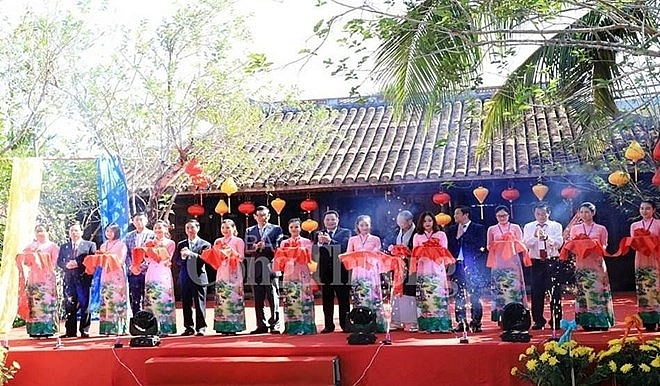Vietnam-International Silk and Brocade Festival opens in Quang Nam
 |
| At the opening ceremony (Photo: congthuong.vn) |
Eight countries, including Italy, France, Japan, India, Thailand and Cambodia, and five cities along with dozens of silk and brocade villages and production facilities of Vietnam are introducing their products at the festival which will last through August 9.
In addition, more than 80 artisans will perform their traditional weaving and dyeing skills at the event.
In the 17-18th century, Hoi An was a famous trading port, sending silk products from Vietnam’s southern region to China, Japan and Europe. Hoi An is now known as a tailoring mecca, with the old town itself having around 400 tailor shops dotted along its alleyways.
Legend has it that silk weaving dated back to the dynasties of Hung Kings, the legendary founders of Vietnam, and through ups and downs of the history, silk weaving has been well preserved at Van Phuc village (Hanoi), Nha Xa village (Ha Nam), Ma Chau village (Quang Nam), Tan Chau village (An Giang), and Bao Loc village (Lam Dong province), among others.
Meanwhile, the art of brocade weaving is a typical cultural feature of ethnic minority groups across the country. Particularly, many ethnic communities have their traditional brocade weaving bestowed with the national intangible cultural heritage status, including Hre in Ba Thanh commune, Quang Ngai province’s Ba To district, Ta Oi in Thua Thien-Hue province’s A Luoi district, and Co Tu in Quang Nam province.
Distinct patterns on unique brocade fabric have been favoured by many fashion designers for years. Most recently, renowned designers Minh Hanh introduced a collection of “ao dai” (Vietnamese traditional dress) made of silk, with brocade patterns frequently used by the Vietnamese ethnic people to Russian fashion-lovers, art critics and researchers. The patterns were hand-woven by female members of ethnic groups across the country.
What the stars mean:
★ Poor ★ ★ Promising ★★★ Good ★★★★ Very good ★★★★★ Exceptional
Related Contents
Latest News
More News
- Free tickets, Lunar New Year promotions on offer at Vietjet Mega Livestream (November 26, 2025 | 15:32)
- UNIQLO unveils upgraded heat-retention wear at Hanoi event (October 26, 2025 | 10:00)
- Vietnam named among world’s top four culinary destinations (October 24, 2025 | 17:09)
- Vietnam and Denmark strengthen dialogue on sustainable fashion (October 20, 2025 | 09:11)
- Fusion rolls out special initiatives to celebrate Vietnamese Women’s Day (October 17, 2025 | 20:00)
- Showcase AC 2025 set to light up Hanoi stage (September 12, 2025 | 18:06)
- Hotel Indigo Saigon The City hosts event to reimagine city’s beloved alleyways (July 23, 2025 | 17:04)
- UNIQLO’s sustainability strategy behind the brand's global growth (June 23, 2025 | 15:42)
- Vietnam International Travel Mart 2025 kicks-off in Hanoi (April 10, 2025 | 17:50)
- Phu Quoc named as one of Asia's 'Best Islands' (March 13, 2025 | 10:24)

 Tag:
Tag:





















 Mobile Version
Mobile Version